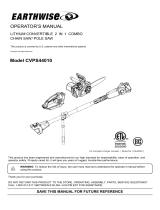
ADJUSTING THE ANGLE OF POLE SAW HEAD (Fig. 20)
1. To adjust the sawing angle, press the angle adjustment button.
2. Turn the saw to the desired angle.
3. The angle can be adjusted between -20 and 60 degrees.
Before you start the unit, make sure the pole/chain saw is not
contacting any object.
STARTING THE POLE/CHAIN SAW
Push the safety button in with your thumb and then squeeze the
switch trigger with your fingers. Once the tool is running, you can
release the safety button. To turn the tool OFF, release the switch
trigger. (Fig. 18)
WARNING: To guard against injury, observe the following:
Read instruction manual before using.
Save instruction manual.
Keep hands away from blades.
Keep hands on handles. Don’t overreach.
A good, firm grip on the pole/ chain saw with both hands will help you
maintain control. Grip the rear handle with your right hand whether
you are right or left handed. Wrap the fingers of your left hand over
and around the front handle when using the chainsaw, or around the
pole shaft when using the pole saw. A firm grip together with
positioning handle against your body will help you maintain control of
the saw. Don’t let go.
WARNING: Do not operate pole saw in a tree, on a ladder, or on a
scaffold; this is extremely dangerous.
CAUTION: Chain coasts after pole saw is turned off. Do not use
under wet conditions.
Use extreme caution when cutting small size brush, saplings or limbs
under tension, because slender and tense material may catch the saw
and be whipped toward you, pull you off balance or spring back.
Do not use saw to cut vines and or small underbrush.
BRAKE
When using the chainsaw, in case an emergency stop is necessary,
use the back of your hand to push the hand guard forward. Chain will
stop immediately. (Fig. 19)
CAUTION: Failure to lubricate the chain will cause damage to the bar
and chain. Use only a good quality bar and chain oil or, if not
available, unused SAE 30 weight motor oil may be substituted. One
minute of use will consume approx. 0.15 fl. oz. (5ml) of oil.
NOTE: It is normal for oil to seep from the chainsaw cutting head
when not in use. To prevent seepage, empty the oil tank after each
use. When storing the unit for a long period of time (3 months or
longer) be sure the chain is lightly lubricated; this will prevent rust on
the chain and bar sprocket.
OPERATING
10
WARNING: Kickback may occur when the moving chain contacts an
object at the upper portion of the tip of the guide bar or when the
wood closes in and pinches the chain saw in the cut. Contact at the
upper portion of the tip of the guide bar can cause the chain to dig
into the object and stop the chain for an instant. The result is a
lightening fast, reverse reaction which kicks the guide bar up and
back toward the operator. If the chain saw is pinched along the top of
the guide bar, the guide bar can be driven rapidly back toward the
operator. Either of these reactions can cause loss of saw control
which can result in serious
injury. Do not rely exclusively
upon the safety devices built
into the saw. As a chain saw
user, you should take several
steps to keep your cutting
jobs free from accident or
injury.
The following precautions should be followed to minimize
kickback:
1. Always grip the pole and/or handles firmly with both hands when
unit is running. When using the chainsaw, place your right hand
on the rear handle and your left hand on the front handle with
your thumbs and fingers encircling the chainsaw handles. When
using as a pole saw, place one hand on the pole and your other
hand on the rear handle with your thumbs and fingers encircling
the pole and handle. A firm grip together with positioning handle
against your body will help you maintain control of the saw if
kickback occurs.
2. Make sure that the area in which you are cutting is free from
obstructions. Do not let the nose of the guide bar contact a log,
branch, fence or any other obstruction that could be hit while you
are operating the saw.
3. Always cut with the unit running at full speed. Fully squeeze the
throttle trigger and maintain a steady cutting speed.
4. Wear non-slip gloves for maximum grip protection.
Cut lower branches first to allow the top branches more room to fall.
Work slowly, keeping both hands on the saw with a firm grip.
Maintain secure footing and balance.
WARNING: To protect yourself from electrocution, maintain a min. of
50 ft. (15m) from over head electrical lines.
WARNING:Keep bystanders at least 50 ft. away.
WARNING: Do not cut trees near electrical wires or buildings.If
chain jams on any electrical cord or line, DO NOT TOUCH THE BAR
AND CHAIN. THEY CAN BECOME ELECTRICALLY LIVE AND
VERY DANGEROUS.
WARNING: Do Not use the pole saw with any type of accessory or
attachment. Such usage might be hazardous.
WARNING: Beware of the cord while operating the saw. Keep the
cord away from the chain. Be careful not to trip over the
extension cord.
FIG.18
KICKBACK
DANGER ZONE
Safety Button
Switch Trigger
FIG.20
Angle Adjustment
Button
-20°
20°
40°
60°
Hand Guard
FIG.19
















